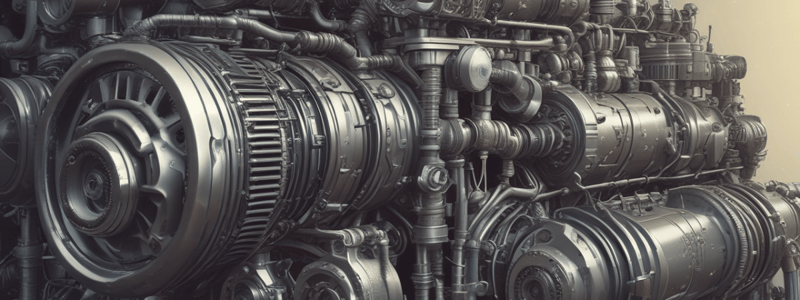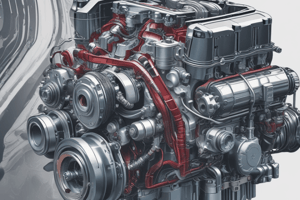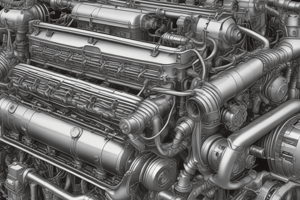Podcast
Questions and Answers
What is the function of the primary winding in the ignition coil?
What is the function of the primary winding in the ignition coil?
- To connect the ignition switch to the vehicle battery
- To complete the primary circuit through the contact breaker points
- To produce a magnetic field (correct)
- To produce a high voltage necessary to create a spark across the plug gap
What is the primary function of an ignition system?
What is the primary function of an ignition system?
- To produce a spark at the plug gap (correct)
- To reduce engine power output
- To reduce fuel efficiency
- To increase engine emissions
What is the common unit of measurement for capacitors in automotive systems?
What is the common unit of measurement for capacitors in automotive systems?
- Millifarad
- Picofarad
- Microfarad (correct)
- Farad
What is the principle of operation of the ignition coils in inductive ignition systems?
What is the principle of operation of the ignition coils in inductive ignition systems?
What is the main function of the contact breaker in a battery ignition system?
What is the main function of the contact breaker in a battery ignition system?
What is the purpose of the laminated soft iron core in the ignition coil?
What is the purpose of the laminated soft iron core in the ignition coil?
Which type of ignition system is used in diesel engines?
Which type of ignition system is used in diesel engines?
What is the ratio of the number of secondary turns to the number of primary turns in the ignition coil?
What is the ratio of the number of secondary turns to the number of primary turns in the ignition coil?
What is the purpose of a capacitor in the ignition system?
What is the purpose of a capacitor in the ignition system?
What is the term for the brief electric arc produced between the electrodes of a spark plug?
What is the term for the brief electric arc produced between the electrodes of a spark plug?
What is the purpose of the condenser in a magneto ignition system?
What is the purpose of the condenser in a magneto ignition system?
What is the main reason for the use of a laminated core in the ignition coil?
What is the main reason for the use of a laminated core in the ignition coil?
What is the primary factor that determines ignition timing in an internal combustion engine?
What is the primary factor that determines ignition timing in an internal combustion engine?
What is the range of voltage required to produce a spark at the plug gap in a cylinder under compression?
What is the range of voltage required to produce a spark at the plug gap in a cylinder under compression?
What is the unit of capacitance?
What is the unit of capacitance?
What is the purpose of the outer soft iron cover in the ignition coil?
What is the purpose of the outer soft iron cover in the ignition coil?
What is the term for firing the spark plug earlier in the ignition cycle?
What is the term for firing the spark plug earlier in the ignition cycle?
What is the effect of relative movement between the magnetic field and conductors in an ignition coil?
What is the effect of relative movement between the magnetic field and conductors in an ignition coil?
What is the purpose of the primary circuit in a battery ignition system?
What is the purpose of the primary circuit in a battery ignition system?
What is the effect of a thinner dielectric on the capacity of a capacitor?
What is the effect of a thinner dielectric on the capacity of a capacitor?
What is the effect of advancing timing on engine performance?
What is the effect of advancing timing on engine performance?
What is the purpose of the centrifugal advance mechanism in older mechanical distributor-based ignition systems?
What is the purpose of the centrifugal advance mechanism in older mechanical distributor-based ignition systems?
What is the function of the vacuum diaphragm in the vacuum advance mechanism?
What is the function of the vacuum diaphragm in the vacuum advance mechanism?
What is the result of retarding timing at lower RPMs?
What is the result of retarding timing at lower RPMs?
What is the advantage of using both centrifugal and vacuum advance mechanisms in an engine?
What is the advantage of using both centrifugal and vacuum advance mechanisms in an engine?
What is the primary function of the ignition system in an internal combustion engine?
What is the primary function of the ignition system in an internal combustion engine?
Which component of the ignition system provides electrical power to the system?
Which component of the ignition system provides electrical power to the system?
What happens when the distributor sends a signal to the ignition coil?
What happens when the distributor sends a signal to the ignition coil?
What type of ignition system uses a mechanical distributor to control spark timing?
What type of ignition system uses a mechanical distributor to control spark timing?
What is the purpose of the ignition coil in the ignition system?
What is the purpose of the ignition coil in the ignition system?
What is the primary function of the Bendix drive in an automobile starter motor?
What is the primary function of the Bendix drive in an automobile starter motor?
What component of the Bendix drive allows the pinion gear to spin freely in one direction?
What component of the Bendix drive allows the pinion gear to spin freely in one direction?
What happens to the starter motor when the engine starts running?
What happens to the starter motor when the engine starts running?
What is the purpose of the neutral safety switch in automatic transmission vehicles?
What is the purpose of the neutral safety switch in automatic transmission vehicles?
What is the result of the pinion gear engaging with the flywheel ring gear?
What is the result of the pinion gear engaging with the flywheel ring gear?
What type of motor is used in the starting system?
What type of motor is used in the starting system?
What component supplies power to the starter motor and ignition system during startup?
What component supplies power to the starter motor and ignition system during startup?
What is the function of the starter solenoid?
What is the function of the starter solenoid?
What engages with the flywheel or flexplate teeth to turn the engine over?
What engages with the flywheel or flexplate teeth to turn the engine over?
What is the main function of the centrifugal and vacuum advance mechanisms?
What is the main function of the centrifugal and vacuum advance mechanisms?
Flashcards are hidden until you start studying
Study Notes
Ignition System in Internal Combustion Engines
- An ignition system is a crucial component in internal combustion engines, responsible for initiating and controlling the combustion process.
- Its primary function is to generate a high-voltage spark at the right moment to ignite the air-fuel mixture within the engine's cylinders.
Components of an Ignition System
- Battery: Provides electrical power to the ignition system.
- Ignition Switch: Controls the ignition system's operation, allowing the driver to start and stop the engine.
- Ignition Coil: Converts low voltage from the battery into high voltage, which is necessary to create a spark at the spark plugs.
- Distributor (or Ignition Module): Distributes high voltage from the ignition coil to the correct cylinder's spark plug at the precise time.
- Spark Plugs: Devices that create a spark to ignite the air-fuel mixture.
Types of Ignition Systems
- Conventional (Mechanical) Ignition Systems: Older systems that use a mechanical distributor to control spark timing.
- Electronic Ignition Systems: Modern systems that use solid-state electronics and sensors to control ignition timing more precisely, improving efficiency and performance.
Importance of Ignition System
- The efficiency and reliability of an ignition system directly impact engine performance, fuel efficiency, and emissions.
- A well-maintained ignition system ensures smooth engine operation and optimum power output.
Battery Ignition System
- Consists of primary ignition circuit (low voltage), secondary ignition circuit (high voltage), ignition switch, contact breaker, capacitor, and spark plugs.
- The primary ignition circuit supplies low voltage to the ignition coil, which steps up the voltage to generate a high-voltage spark.
Magneto Ignition System
- Uses a magneto to generate electric current for producing spark.
- Main components include frame, permanent magnet, armature, soft iron field, rotor, primary and secondary winding, contact breaker, and condenser.
Ignition Timing
- Refers to the precise moment when the spark plugs fire in the cylinders of an internal combustion engine.
- Timing is crucial because it determines when the fuel-air mixture ignites, which directly affects engine performance, fuel efficiency, and emissions.
Factors Affecting Ignition Timing
- Engine speed, load, and fuel quality.
- Mechanical vs. electronic methods of adjusting ignition timing.
- Advance and retard timing to optimize engine performance.
Ignition Advance Mechanism
-
Centrifugal Advance Mechanism:
- Adjusts ignition timing based on engine speed.
- Uses centrifugal weights and springs to rotate the distributor shaft and advance the spark timing.
-
Vacuum Advance Mechanism:
- Adjusts ignition timing based on engine load and vacuum pressure.
- Uses a vacuum sensor to advance the spark timing when the engine is under load.### Ignition Timing
-
The amount of advance in ignition timing is designed to compensate for the time it takes for combustion to complete at higher engine speeds, optimizing engine performance.
-
Centrifugal advance mechanisms are mechanical and work without additional sensors or electronic controls, making them reliable and effective for adjusting ignition timing based on engine speed variations.
-
Vacuum advance mechanisms are used in conjunction with centrifugal advance to optimize ignition timing based on engine load conditions.
-
During light throttle or low-load conditions, vacuum advance mechanisms advance the timing to improve fuel efficiency and reduce emissions.
-
Under heavy load or full throttle, vacuum advance mechanisms retard the timing to prevent knocking or pre-ignition.
Starting System
- The starting system is responsible for initiating the engine's operation from a stationary position.
- Components of the starting system include:
- Battery: provides electrical energy to power the starting system
- Starter Motor: an electric motor specifically designed for high torque output
- Starter Solenoid: a relay switch that controls the high current needed to operate the starter motor
- Ignition Switch: controls the flow of electrical power to the starter solenoid and other electrical systems
- Starter Relay: controls the flow of current to the starter solenoid (in some vehicles)
- Flywheel or Flex plate: toothed wheel attached to the engine's crankshaft
- Operation of the starting system involves:
- Initiation: electrical power flows from the battery to the starter motor
- Starter solenoid activation: the starter relay or ignition switch sends a signal to the starter solenoid
- Starter motor engagement: the starter motor spins and its drive gear extends to engage with the flywheel or flex plate teeth
- Cranking the engine: the starter motor cranks the engine by turning the flywheel or flex plate
- Engine start: the engine fires and begins to run under its own power
Bendix Drive
- The Bendix drive is a type of starter drive mechanism commonly used in automobile starter motors.
- Its primary function is to engage the starter motor with the engine's flywheel ring gear to start the engine.
- The Bendix drive consists of a pinion gear mounted on an overrunning clutch mechanism.
- The pinion gear is typically a helical gear mounted on a shaft connected to the armature shaft of the starter motor.
- The overrunning clutch allows the pinion gear to spin freely in one direction and locks it in the opposite direction, engaging with the flywheel.
- The working process of the Bendix drive involves:
- Starting process initiation: electrical current flows to the starter solenoid, which activates the starter motor
- Pinion gear movement: the Bendix drive shaft rotates, moving the pinion gear towards the flywheel due to centrifugal force or a mechanical mechanism
- Engagement with flywheel: the pinion gear engages with the flywheel ring gear, meshing with the teeth and transferring rotational motion from the starter motor to the engine's crankshaft
- Engine starting: the engagement allows the starter motor to crank the engine
- Automatic disengagement: once the engine starts running, the overrunning clutch mechanism allows the pinion gear to spin freely, disengaging it from the flywheel ring gear.
Studying That Suits You
Use AI to generate personalized quizzes and flashcards to suit your learning preferences.





